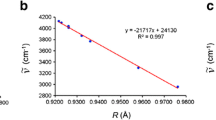Summary
The marked solubility of coumarin in aqueous mineral acids is attributed to the formation of complexes. That this takes place through hydrogen bonds is shown by a study of the Raman spectrum of these solutions wherein the carbonyl frequency is found to be considerably lowered, but still persists.
Similar content being viewed by others
References
Murty and SesiradriProc. Iad. Acad. Sci., A, 1942,15, 157.
—Ibid., 1941,14, 601.
—Ibid., 1942,15, 241.
—Ibid., 1939,10, 315.
—Ibid., 1941,14, 598; 1938,8, 520.
Author information
Authors and Affiliations
Rights and permissions
About this article
Cite this article
Murty, G.V.L.N., Seshadri, T.R. Raman effect and Hydrogen Bonds. Proc. Indian Acad. Sci. (Math. Sci.) 17, 55–57 (1943). https://doi.org/10.1007/BF03053041
Received:
Issue Date:
DOI: https://doi.org/10.1007/BF03053041




